Recent Posts
-
And Yet, We Go On
April 22, 2024
-
It IS Happening Here
February 16, 2024
-
General Ludd to General Intellect
January 11, 2024
-
Temporal and Geographic Edges
December 26, 2023
-
The Root of All Evil
October 13, 2023
-
Post-Pandemic Melancholia . . . Same As It Ever Was?
September 3, 2023
-
Chronicle of Deaths Foretold
June 24, 2023
-
Reparations is the Least We Should Do
May 11, 2023
-
We Are Not Alone
April 9, 2023
-
War and Anti-War
February 22, 2023
|
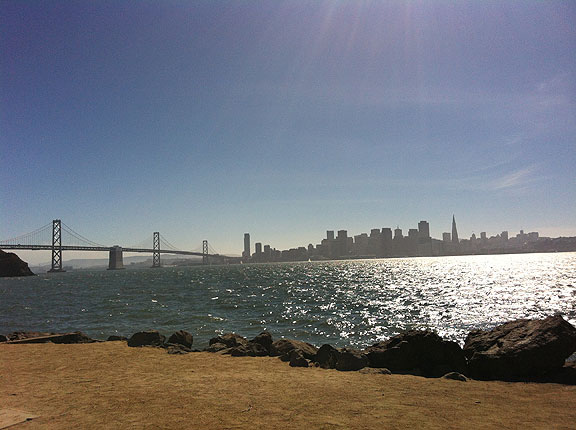 San Francisco and the Bay Bridge from Clipper Cove park on Yerba Buena Island. Photo: Adriana Camarena International Car-Free Day, September 22, is a day that in the Bay Area we don’t normally pay much attention to. But given that the week-long festival celebrating Critical Mass was just beginning, this year we had to do something special. So we went to the middle of the San Francisco bay to have a Car-Free Day Picnic! Yes, it took three van-loads to get us all there with our bicycles, but after a somewhat contradictory and ironic interlude of driving back and forth, the picnic was underway under sunny skies, sheltered from the mounting wind and fog rolling in through the Golden Gate as the afternoon started to wane.
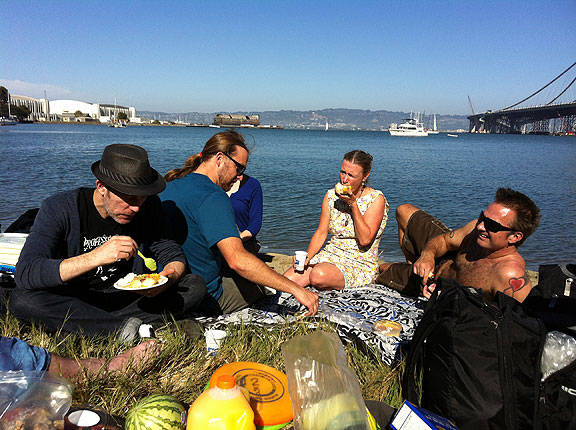 Car-Free Day Picnic in Clipper Cove, Yerba Buena Island, Sept. 22, 2012. Photo: Adriana Camarena 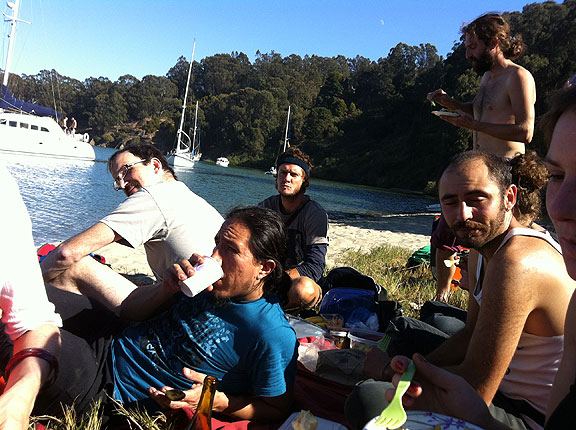 Car-Free Day Picnic in Clipper Cove, Yerba Buena Island, Sept. 22, 2012. Photo: Adriana Camarena 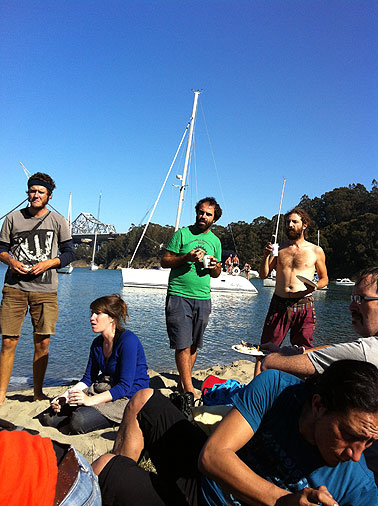 Car-Free Day Picnic in Clipper Cove, Yerba Buena Island, Sept. 22, 2012. Photo: Adriana Camarena Just the day before, Friday September 21, was International Park(ing) Day, when people take over parking places and turn them into parks for the day. It was well represented along Valencia Street, where a half dozen permanent parklets have replaced parking places during the past couple of years. Park(ing) Day started in San Francisco about six or seven years ago, instigated by the folks at Rebar, and it, like Critical Mass, has spread around the world.
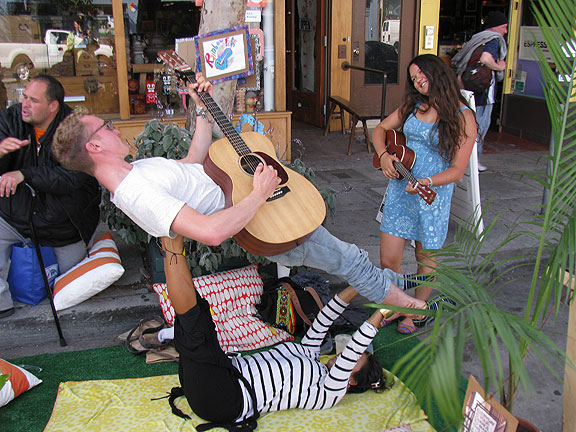 Look what people do with parking spaces when Park(ing) Day rolls around!  The Valencia Pop-Up Habitat was one of the coolest of the day's reclaimed spaces. 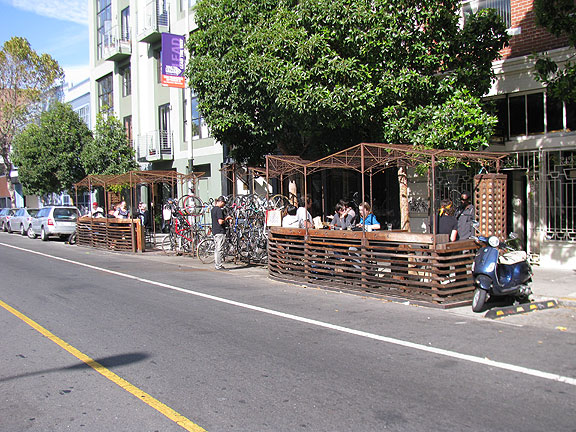 Park(ing) Day didn't have quite the participation as in recent years, perhaps because so many delighteful parklets have been established permanently... This one in front of Four Barrel Coffee is one of the best. But back to our Car-Free Day Picnic. Our choice of location wasn’t accidental. Recently California’s Transportation bureaucracy (Caltrans) affirmed that they are studying a long-term plan to make bicycle and pedestrian crossing possible, in light of the fact that next year the new east span will open with its separate bike-and-pedestrian lane alongside, allowing people to leave the East Bay and make it as far as the middle of the Bay. From there, to make it all the way across the Bay to San Francisco, you’re basically stuck waiting for a bus that runs every 20 minutes and will only accommodate 2 bicycles per journey. In other words, the Caltrans plan to accommodate bike and pedestrian bridge traffic is a farce! (A fuller argument about Bay Bridge access is appended at the end of this account below.)
We wanted to bicycle back to San Francisco as an act of civil disobedience, not to get arrested, but to physically demonstrate the necessity of access to the Bay Bridge, and to underscore our simple and cheap solution. Go back to the 6-lane configuration that existed from the 1937 bridge opening to 1962, and give the sixth lane to bicycles and pedestrians—all this for a few thousand dollars and a day or two of work, compared to the 10 years and $1 billion estimated by Caltrans for their hair-brained scheme. We came very close to riding the bridge, but due to an unpredictable sequence of events, our plans were thwarted.
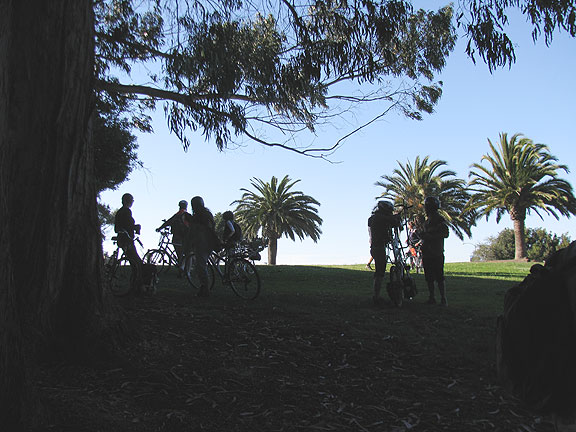 We waited for the right moment to head up to the Bridge. As we finished our convivial picnic and mustered our determination to cross the bridge, the word arrived that the California Highway Patrol (CHP) had pulled a car off the bridge and the officer was ticketing them just below our starting point. OK, we would wait. Then it turned out that the motorist was being put in handcuffs, arrested, his passengers evicted from the automobile, and the car was being impounded. More CHP, and a further wait for a tow truck. Finally after 45 minutes it was over and the CHP drove away (or so we thought). Our plan to enter the fast-moving traffic at the Yerba Buena Island entrance was to use a vehicle to block for us, rolling into the right lane with flashers on in a way that we could maneuver ourselves in front of it. Then they would stay behind us as a protective barrier as we would be riding at 10-15 mph while the cars were whizzing by at 45-50 mph.
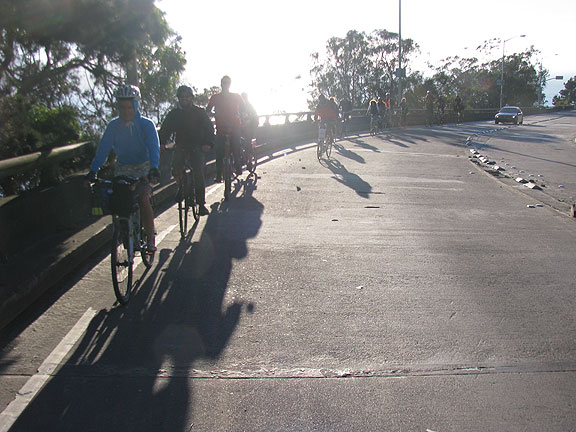 Riding up to the onramp to the Bridge. There were high winds by the time we started our approach to the bridge but our adrenaline was flowing and all 17 of us were ready to make the ride. We rode up the long incline to the ramp that curves down to the beginning of the Bay Bridge’s west span. As we reached the entry point we divided ourselves along right and left and let cars pass us, expecting our support vehicle to appear in seconds.
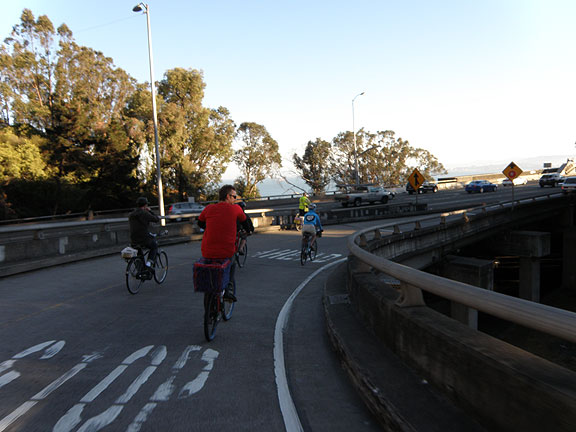 Rolling to Bridge entry. Photo: Paul, Bike Cavalry 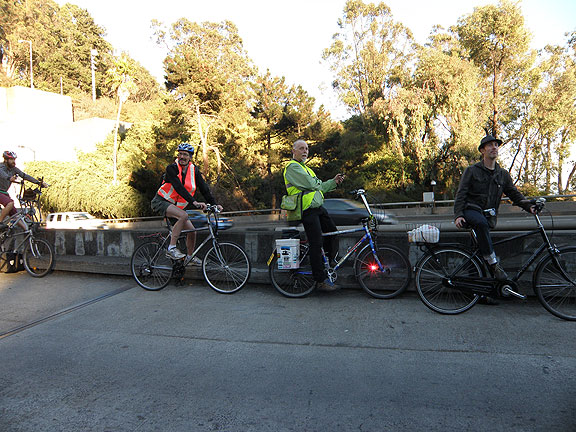 Waiting for the help... Photo: Paul, Bike Cavalry 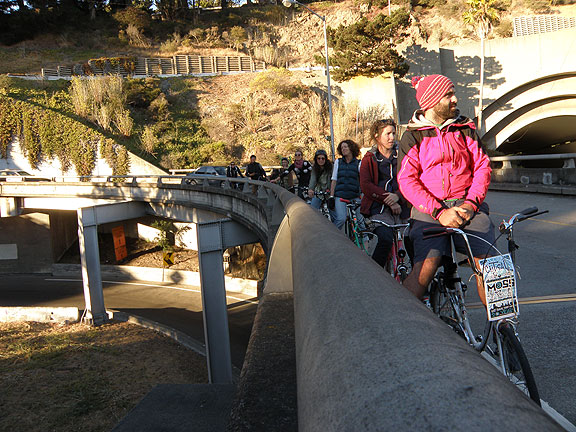 All lined up, only the Bridge ahead! Photo: Paul, Bike Cavalry Two or three long minutes went by without seeing him, and then suddenly there was a CHP vehicle (later we learned it was the same officer that had the arrested driver in the back of his car—why had he returned to the island? A mystery) who upon seeing us boomed out from his PA system: “All you bicyclists MUST NOT ENTER THE BRIDGE! Turn around now!” We felt caught, so we started to circle back to demonstrate compliance. Still our support vehicle had not appeared, but just as we were riding up the ramp, there he was. Now what? Some people wanted to turn around and go for it. Many others had lost their will. Continue reading The Switch is On! 20th Anniversary Celebration Has Begun…
Yep, that’s what it feels like these days. Just realized it’s been nearly 2 months again since I last blogged. Goes to show you, I’ve been darn busy. We are less than a week from the San Francisco Critical Mass 20th anniversary week of festivities. Our new book, Shift Happens! Critical Mass at 20, is back from the printer and available at some of the better local independent bookstores as well as online here. Hell, we even made a kindle version!
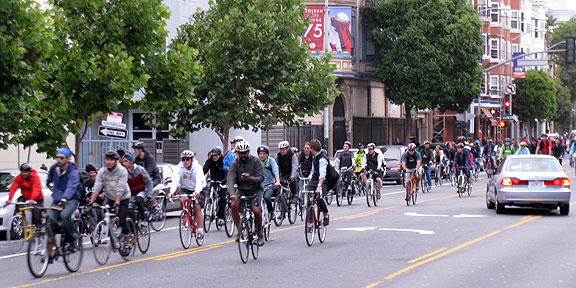 Just a fraction of the August Critical Mass heading south on Valencia... While Not Blogging, I’ve been doing a bunch of other projects, including the interview I’m reposting below with David Harvey about his book Rebel Cities, which is well worth reading. I had to reconjure the “Ghost Streets” article I did a couple of years ago for a journal called MAS Context. There’s an interview with me in Spanish on Spain’s Vida Sana website, covering Critical Mass, the anniversary, Nowtopia, and more. Last week I was badly overbooked, appearing on Tuesday night at the Kitchen Table Talks at 18 Reasons Why, Wednesday we had our regular Talk at our new Shaping San Francisco space at 518 Valencia on “Mexico Today: Dinosaurs, Hashtags, and Popular Revolt,” Thursday I appeared at SPUR with Robin Shulman telling “A Tale of Two Cities’ Food Histories,” on Friday I gave a bike tour for a USF class, and then Saturday I gave a short walking tour in Gerbode Valley in the Marin Headlands as part of the Marin Headlands Center for the Arts 30th birthday party. Finally had a day off on Sunday, but I’ll be teaching my class at SFAI tomorrow, and on Wednesday back at SPUR again for a discussion on “150 Years South of the Slot” about the history of Yerba Buena Gardens area. Whew! And now we plunge into the 8 days of festivities for the Critical Mass 20th anniversary! Maybe I will relax in October!
Meanwhile, here’s the email exchange I had with David Harvey about his most recent book “Rebel Cities: From the Right to the City to Urban Revolution”. I have to say it was very gracious of him to engage with this, which was instigated by the good folks over at Shareable.net.
I want to start with the opening paragraph of his preface titled “Henri Lefebvre’s Vision” where Harvey reminisces about a poster he acquired in Paris in the mid-1970s… curiously I have the very same poster, equally tattered, on my wall. Here’s a photo of it, and his paragraph, after is the exchange:
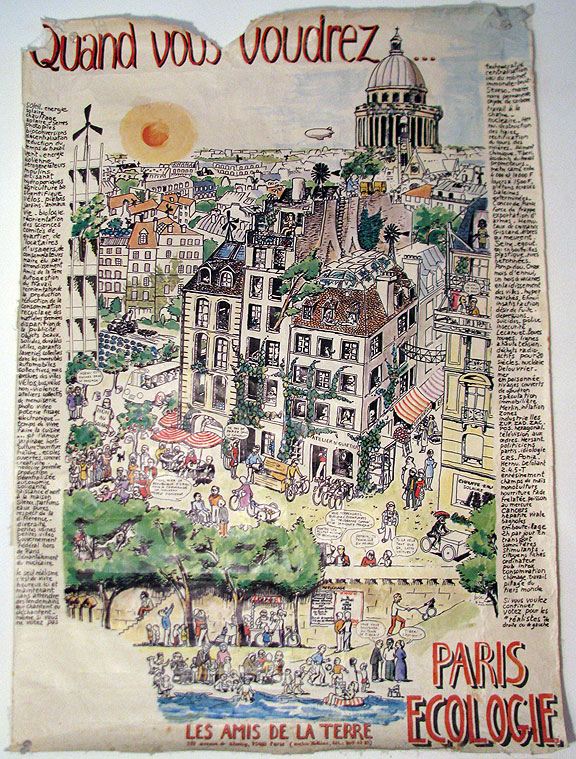
Sometime in the mid 1970s in Paris I came across a poster put out by the Ecologistes, a radical neighborhood action movement dedicated to creating a more ecologically sensitive mode of city living depicting an alternative vision for the city. It was a wonderful ludic portrait of old Paris reanimated by a neighborhood life, with flowers on balconies, squares full of people and children, small stores and workshops open to the world, cafés galore, fountains flowing, people relishing the river bank, community gardens here and there (maybe I have invented that in my memory), evident time to enjoy conversations or smoke a pipe (a habit not at that time demonized, as I found to my cost when I went to an Ecologiste neighborhood meeting in a densely smoke-filled room). I loved that poster, but over the years it became so tattered and torn that I had, to my regret, to throw it out. I wish I had it back! Somebody should reprint it.
Chris Carlsson: Who did you write Rebel Cities for?
David Harvey: My aim was to write a book for everyone who has serious questions about the qualities of the urban life to which they are exposed and the limited choices that arise, given the way in which political and economic power asserts a hegemonic right to build cities according to its own desires and needs (for profit and capital accumulation) rather than to satisfy the needs of people.
In so doing, I wanted to provide indications of the kind of theoretical framework to which I appeal and I, therefore, use seemingly abstract (often, but not exclusively, Marxist) concepts. But my aim is to use these concepts in such a way that anybody can grasp them. (I don’t always succeed, of course.) I then hope that people might become interested to seek a deeper knowledge of the sort of framework that I use. For example, in “The Art of Rent,” I use a seemingly arcane concept of monopoly rent, but I hope by the end of the chapter people can understand very well what it might mean and wonder how it is that a society that lauds competition as foundational to its functioning is populated by capitalists who will go to great lengths to secure monopoly power by any means and how they capture unearned rents by resorting to that power.
If people want a broader understanding of my framework, they can use many resources including my own Enigma of Capital, and A Brief History of Neoliberalism, and my website lectures (including those on Marx’s Capital) and the Companion to Marx’s Capital). I hope, however, that Rebel Cities is understandable enough without going through all of those materials first. In my view, one of the biggest problems for anti-capitalist social movements in our times is the lack of an agreed-upon framework to understand the dynamics of what is going on; if I can somehow incite activists to think more broadly about what they are doing and the general situation in which they are doing it (and how particular struggles relate to each other), then I would be very happy. Continue reading Hurtling Into Autumn; “Rebel Cities”
I’ve been reading Robin Shulman’s entertaining book “Eat the City” about the history and practice of growing food in New York City. I’ll be appearing with her in discussion at SPUR on September 13, so they kindly sent me a review copy. She opens the book with a long chapter about honey and beekeeping in New York, following a guy who has built a business out of maintaining various hives, collecting swarms when they appear, and generally being a successful entrepreneur while cultivating his rugged individualist curmudgeonliness. Shulman’s prose is a pleasure to read, she wastes no words while spinning beautiful and charming stories.
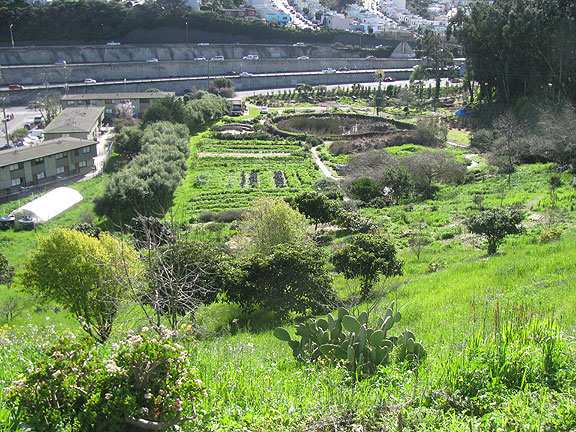 San Francisco's Alemany Farm adjacent to Interstate 280. Food continues to be the main way in for a lot of folks to a practical transformation in the here-and-now. They can change their eating habits, they get involved in gardening or shopping with local farmers at a farmers market, or gleaning and foraging for wild herbs and fruits in their city neighborhoods. (An inspiring example I came upon recently is the Peterson Garden Project in Chicago.) It’s also an escape of sorts, a way to carry on working at pernicious jobs for high-tech companies or biotech companies while establishing a self-righteousness derived from “at least” doing your best to eat well and support artisanal production (this is the basic goal of the Slow Food movement, at least in the U.S.—in Italy where it started it has deeper roots in working class and traditional proletarian farming communities). My pal Rebecca Solnit writes about the dual nature of the current renaissance in urban agriculture in “Revolutionary Plots” in the latest Orion magazine, highlighting other mutual friends at the Alemany Farm while also decrying the easy withdrawal it provides to the affluent foodies that are sustaining the gentrifying restaurant boom in our neighborhood. Meanwhile Brazilian friends are busy with a series of projects, including urban horticulture and seed exchange picnics and a “have less, live more” festival.
Bernard Marszalek, in a recent Counterpunch posting (condolences to all on the passing of Alexander Cockburn, a friend who I hadn’t known well but always enjoyed in spite or because of his orneriness) addresses the oft-invoked model of the multinational cooperative Mondragon, a Spanish-based corporation that encompasses dozens of enterprises all owned and run by the workers themselves. Naturally a lot of people look to Mondragon as a hopeful model of another way to live and work in the world as we know it:
The statistics of Mondragon’s success ($17bn. sales in 2011), number of employees (83,569) and international expansion (94 subsidiaries in 17 countries), means that Mondragon must navigate global trade, which generates 70 percent of its income, with a keen awareness of the opportunities to make profitable investments, not unlike a traditional corporation. The savvy managers of this vast economic conglomerate put to shame the corrupt corporate CEOs, worldwide, who create wealth by controlling politicians and manipulating financial markets.
We have come to expect corporate malfeasance, however, when we come across a corporation abiding by a higher standard, we need to temper our enthusiasm and sharpen our critical faculties. MC abides by outstanding principles regarding the dignity of work and the betterment of their community, but when the corporation enters the arena of international trade, these ethical premises are challenged by the bottom-line mentality. This conundrum cannot be ignored. Every worker cooperative must deal with the marketplace and its diktats and limit, to the best of its ability, their corrosive effects on daily operations. Mondragon, since it contends with these issues on such an immense scale, attempts to balance the real world’s ethical comprises with their internal values with increasing difficulty. Its overseas investments, for instance, are motivated solely by financial concerns; they do not invest to create cooperatives with the 15,000 workers they employee in other countries.
Taking a much longer look, 300 years in the future, Kim Stanley Robinson’s latest novel 2312 posits that “the Mondragon” is an interplanetary political force based on mutual aid and solidarity, one that has grown to the point of being the biggest, most coherent political ideology in the galaxy! Imagine that! Continue reading Nowtopia Percolating
|
|


























